Hong Kong noodles are egg noodles stir-fried with meat and vegetables in sesame oil. Topped with chopped spring onions, this springy Cantonese noodle dish is smoky, savoury and an absolute crowd favourite.
You will usually see Cantonese chow mein dish served in Asian restaurants with a mixture of meat and vegetables. In some restaurants, Cantonese noodles have an extra crispy, charred bottom that the chef tops off with sauce.
For our recipe, we mimicked the taste of the dish we ate in Hong Kong and our mum's recipe before finally settling on our own version.
Follow along for our stir-fry Hong Kong noodles recipe, which you can customise with any toppings. Our homemade version is much healthier, as we use much less oil than restaurants. But you can always control the amount of oil that goes into the wok.
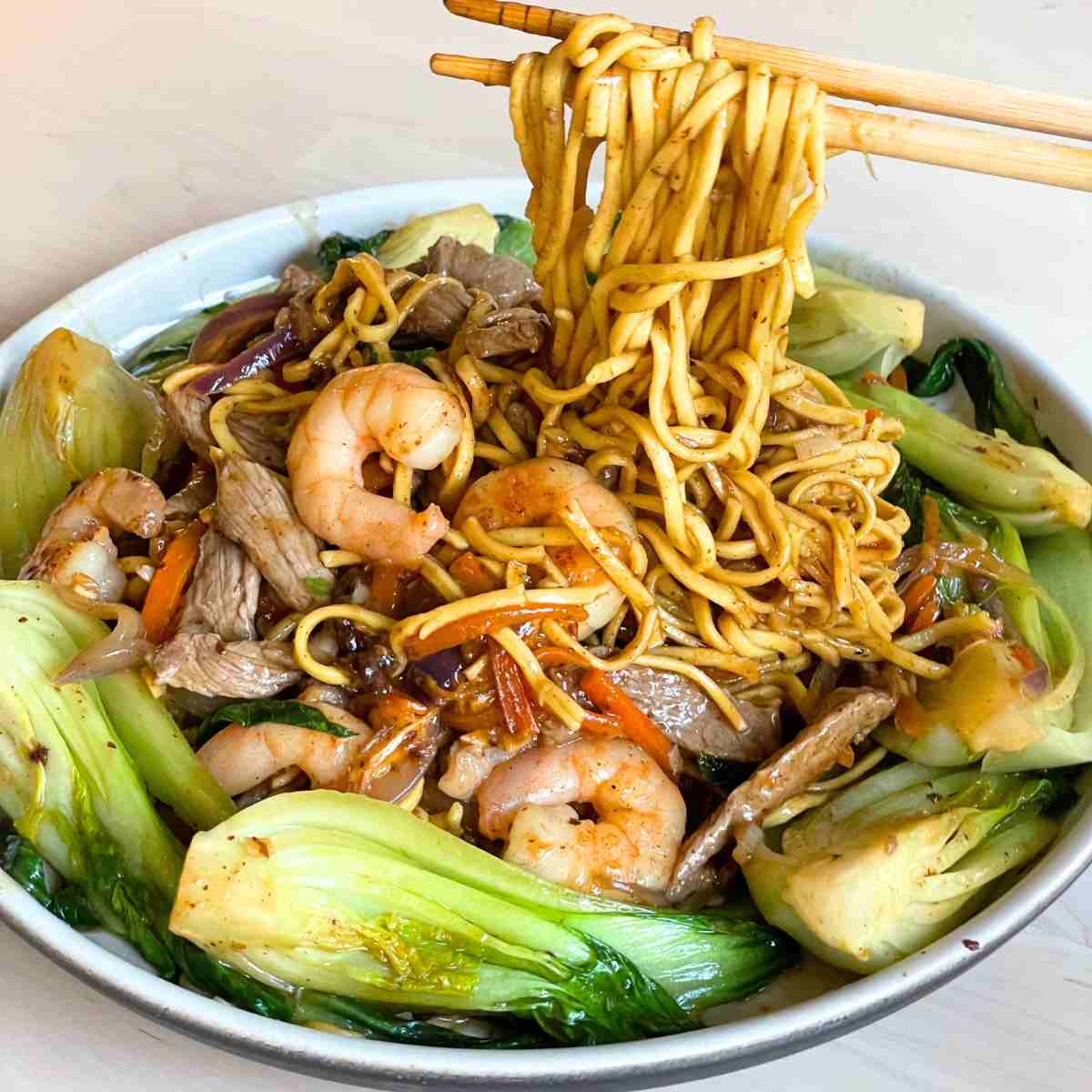
Jump to:
Hong Kong Noodles Ingredients
Here are the ingredients you'll need for our Cantonese recipe:
- 200 g sirloin steak (thinly sliced)
- 120 g dried Hong Kong noodles
- 2 heads baby bok choy, quartered
- 2 cloves garlic, minced
- 1 inch ginger, minced
- ½ yellow or red onion
- ½ carrot, julienned
- 3 tablespoon sesame oil, divided into 3 portions
Shrimp:
- 8 peeled and deveined shrimp
- ½ tablespoon Shaoxing wine
Beef Marinade:
- 1 tablespoon Shaoxing wine
- 1 teaspoon cornstarch
- ¼ teaspoon salt
Sauce
- 0.5 cup low-sodium beef broth
- 1 tablespoon light soy sauce
- 1 tablespoon oyster sauce
- 1 tablespoon Shaoxing wine
- 1 tablespoon cornstarch
- 2 tablespoon noodle water (or plain water)
- ½ teaspoon sugar
Our Cantonese noodles sauce combines beef broth, soy sauce, oyster sauce, Shaoxing wine, sugar and cornstarch. If you're just making the sauce without the noodles, you'll also need to add sesame oil. Since we'll be stir frying the prawns, beef and vegetables using sesame oil, we've omitted it from the sauce ingredients.
Noodles
Using a Hong Kong noodles packet is key to the dish since its firm texture holds well even under hot stir-frying conditions. Fresh, flat egg-based strands have a light dust of cornstarch coating and come in a patty shape. However, there are many types of egg noodles.

If you're buying dried ones, we recommend buying ones that are medium thick. The thickness should be close to that of regular spaghetti or Japanese soba. You'll also need to boil them in hot water to rehydrate them.

Meat or Seafood
We recommend using either sirloin, beef brisket, flank steak or skirt steak in our Hong Kong pan-fried noodles recipe. Although these are cheaper cuts of meats, they remain tender and juicy after cooking.
However, you can also replace beef with sliced chicken breast. Chicken cooked in Cantonese noodles is typically more chewy but goes well with the chow mein.

Alternatively, you'll also find Hong Kong-style fried noodles with seafood. Instead of beef, you can use a mix of large prawns, shrimp, squids, and scallops. Seafood adds a light sweetness to the dish, while the white flesh retains the bouncy texture.
Vegetables
When it comes to vegetables for Hong Kong noodle ingredients, most will go well. We love adding scallions, choi sum, and kailan as they have crunchy stems and leafy parts that are great for our noodle dish.

We know some chefs will also add chewy slices of mushrooms with carrots. Ginger and green onions are usually added because they contrast the smooth strands sharply. You can add more leafy or crunchy vegetables if you enjoy the taste. However, we recommend not adding more than 3 types. Otherwise you will overcomplicate the textures in this dish.
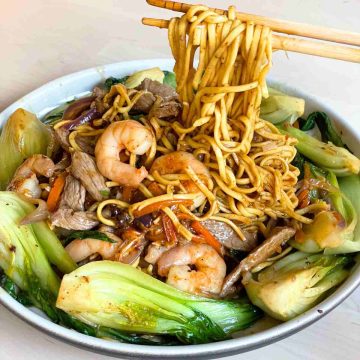
Hong Kong Noodles Recipe (Cantonese Chow Mein)
Ingredients
- 200 g beef thinly sliced
- 120 g egg noodles dried or fresh
- 2 bok choy quartered
- 2 clove garlic minced
- 1 inch ginger minced
- ½ onion yellow or red onion
- ½ carrot julienned
- 3 tablespoon sesame oil
- 8 shrimp peeled and deveined
- ½ tablespoon Shaoxing wine
Beef Marinade
- 1 tablespoon Shaoxing wine
- 1 teaspoon cornstarch
- ¼ teaspoon salt
Sauce
- 0.5 cup beef broth low-sodium
- 1 tablespoon light soy sauce
- 1 tablespoon oyster sauce
- 1 tablespoon Shaoxing wine
- 1 tablespoon cornstarch
- ½ teaspoon sugar
- 2 tablespoon noodle water or plain water
Cooking Instructions
- Marinate the beef with Shaoxing wine and salt in a medium-sized bowl. Allow to marinate for at least 20 minutes. Cook the dried Hong Kong egg noodles according to the package instructions but until al-dente (slightly undercooked). Rinse and drain the noodle strands and set them aside to dry.
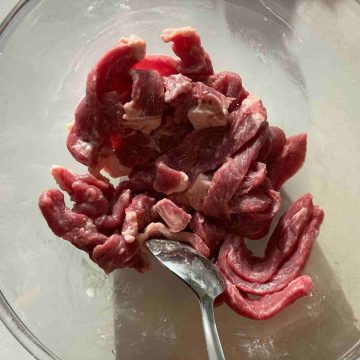
- Heat a large pan or wok with 1 tablespoon of sesame oil over medium-high heat until hot. Toss in the shrimp, add Chinese Shaoxing wine and stir fry for about 2 minutes before setting it aside.
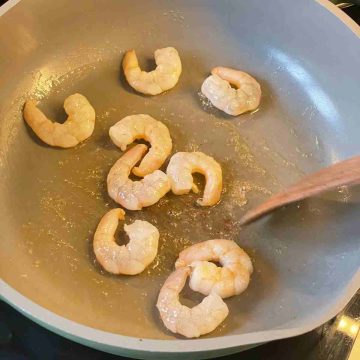
- Set the al-dente strands in the wok and cook under medium heat without flipping for about 1 to 2 minutes or until the bottom side chars slightly. Then, turn the patty to fry the other side for another 1.5 minutes or until golden. Remove from the pan or wok.
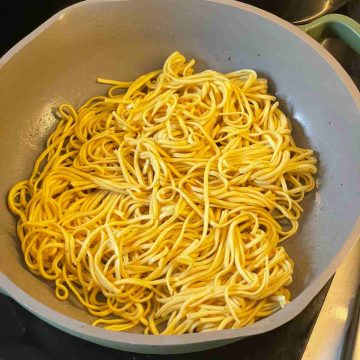
- Then, add 1 tablespoon of sesame oil to the pan or wok. Once the oil is hot, spread the beef slices around the pan or wok and cook it for about 1 minute or until golden brown. Then, flip the beef to cook the other side for another minute. Take it out and set it aside.
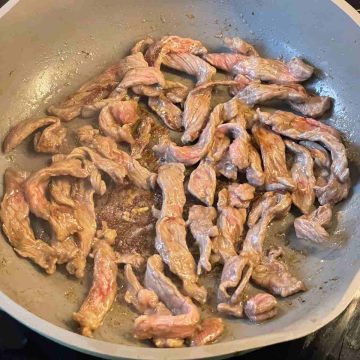
- Add the last tablespoon of sesame oil, and once it's hot, add the ginger, onion and garlic and stir fry for 30 seconds before adding the julienned carrots. Fry for about 1 minute under medium-high heat. Then add the bok choy, followed by the sauce. Then, close the lid to the pan or wok and allow the ingredients to steam for about 1 to 1.5 minutes. Once the sauce has thickened, reduce the heat to medium-low and remove the bok choy.
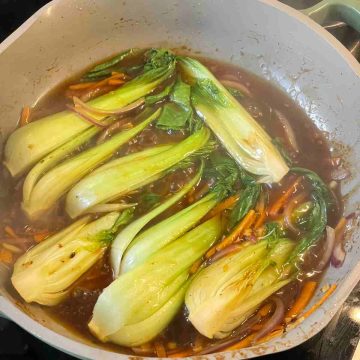
- Then, add the beef, noodles, and shrimp and toss them until they are well-mixed. Now you are done with our stir-fry Hong Kong noodles recipe and ready to serve.
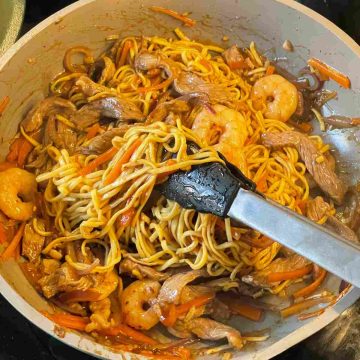
Nutrition
Calories have been calculated using an online calculator. Nutritional information offered on Honest Food Talks is for general information purposes and is only a rough estimate.
Cooking Tips To Make Hong Kong Noodles
If you are ready to try tossing up a storm with our Hong Kong style fried noodles recipe, we've got some cooking tips for you.

How to slice meat thinly
To slice the beef thinly, I recommend placing the steak in the freezer for about 20-30 minutes before slicing. This will harden the steak slightly, making it easier to cut.
Softer flavourful meat
You can marinate the beef or chicken for longer to enhance the meat flavour. Marinating the meat with salt, cornstarch and Shaoxing wine helps break down the fibres and give you a softer, velvety mouthfeel.
We recommend doing this for an hour before you start cooking your Hong Kong noodles. Another way is to slice against the grain while preparing your meat cuts. Cutting against the grain shortens the fibres, which makes the meat softer and easier to chew.
How to fry Cantonese noodles
Heat one tablespoon of oil over medium-high heat in a frying pan or wok. You will know that it's ready for frying when your oil is glistening in the wok and swirls very easily.
Another method is to put a wooden spoon into the pool of oil. Tiny bubbles will form, indicating that it's hot enough to cook. However, this will only work if you're using a lot of oil.
We also recommend sticking to sesame oil as it's a key component of the dish. If not, it becomes a regular fried noodles recipe.
How to avoid overcooking the meat
Avoid overcooking meat, as too much heat can cause it to dry and the protein structure to toughen. If you slice the meat thinly, you should cook it under medium-high heat for only 1 minute on each side. Only add the meat to the pan once it is hot and immediately remove it once it is done.
If some parts of your meat are still slightly pinkish at this stage, don't worry. The residual heat will continue cooking the meat. In addition, when you stir fry it with the other ingredients, it will continue to cook.

If you add seafood to your Hong Kong pan-fried noodles recipe, you must be careful not to overcook it as the muscles are soft and easily ruined. To avoid overcooking shrimp, you should cook the shrimp first. Add them to the frying pan under medium-high heat once it is hot. For seafood, you want to cook them for just 2 minutes until the flesh is pink and opaque. Then, take them out and start cooking the rest of the ingredients.
Baking Or Air Frying Method
Personally, we don't think baking or air frying is a good method for cooking this Cantonese dish. It's like making fried rice using an oven or air fryer. However, we understand that some people don't want to use so much oil.
Set your oven to 230 degrees Celsius (450 Fahrenheit) and bake for 20-30 minutes until golden brown. You can also use an air fryer for cooking this Chinese stir-fried dish. Set it for 10 minutes at 350 degrees Celsius (approx 660 Fahrenheit).
Other additions
You can also use minced chicken to make meatballs, which add a burst of flavour to your final dish. Try our sweet and sour chicken balls recipe if you need a chicken side to add some oomph to your plate of chow mein.
Some creative chefs have also tried adding lobster cheese. Check out our shrimp chow mein recipe if you want a simple, no-frills seafood mein recipe.
If you can't find Hong Kong egg noodles, you can try using ramen. Japanese ramen strands are slightly thinner, and the texture is more slippery. While the thinner consistency won't make a difference to the final taste, you will need to adjust the way you cook them.
First you'll need to boil them before you stir fry. We recommend cooking them for 2 minutes less than the package instructions. As the thinner strands will break apart easily, you should avoiding pulling the noodles more than required. Instead use tossing motions with the spatula, to ensure the strangs are evenly covered in the toppings and sauce.
Difference Between Hong Kong Noodles And Chow Mein
Although Hong Kong noodles are sometimes called stir fry chow mein, the former refers to pan-fried noodles, which are partially cooked in boiling water so that they are ready for stir-frying.
In contrast, chow mein is a Cantonese term that directly translates into fried (chow) noodles (mein). However, if you prefer, you can use other variations, such as thin wonton strands, for your Hong Kong noodles recipe.
Chow mein is relatively ubiquitous around the world. The Japanese have their version of chow mein, also known as yaki udon.
Hong Kong Noodles Vs Singapore Noodles
Hong Kong noodles are sometimes mistaken for their Singaporean counterpart as both are stir-fried plates with meat and vegetables. However, if you look closer, you will notice that the Singaporean version uses vermicelli (thin strands made from maida flour) and curry powder. Conversely, our Hong Kong style egg noodles recipe contains egg-based strands, which are flat and much thicker than vermicelli and soy sauces.
Interestingly, both dishes originated from Kowloon, but as Cantonese cooks travelled around the world, the country 'Singapore' somehow stuck and became synonymous with the plate. What is the best way to enjoy this steaming hot plate of mien? Why not pair it with a chilly cold cup of Hong Kong milk tea?
If you want more of these tempting Asian recipes, hop over to our Instagram @honestfoodtalks.

Leave a Reply